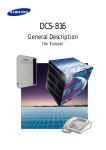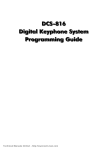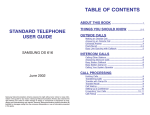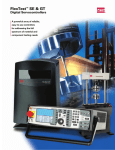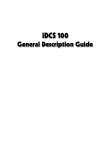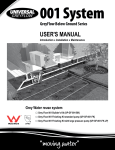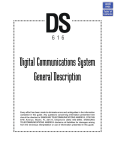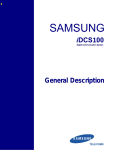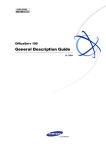Download Samsung DCS-408 Specifications
Transcript
¶ iii SAMSUNG ELECTRONICS CO. LTD. Publication Information Samsung Electronics reserves the right without prior notice to revise information in this publication for any reason. Samsung Electronics also reserves the right without prior notices to make changes in design or components of equipment as engineering and manufacturing may warrant. Copyright 2000 Samsung Electronics Co. Ltd. All rights reserved. No part of this manual may be reproduced in any form or any means graphic, electronic or mechanical, including recording, taping, photocopying or information retrieval systems - without express written permission of the publisher of this material. February, 2000 iv Table of Contents Chapter 1 System Overview.................................................................... 1-1~1-4 Introduction ...................................................................................................................... 1-1 Size and configuration ..................................................................................................... 1-2 408 Base KSU ............................................................................................................... 1-2 Technology .................................................................................................................... 1-2 Programming .................................................................................................................... 1-3 Chapter 2 Hardware Descriptions............................................................ 2-1~2-6 DCS-408 Basic key service unit ....................................................................................... 2-1 408 Base key service unit ............................................................................................ 2-1 System Capacity .............................................................................................................. 2-1 System View .................................................................................................................... 2-2 Front View of DCS-408 ................................................................................................ 2-2 DCS-408 System Port(After Removing side cover) ...................................................... 2-2 Bottom View of DCS-408 ............................................................................................. 2-3 System Specification ........................................................................................................ 2-4 Chapter 3 Features ............................................................................... 3-1~3-36 System features ............................................................................................................ 3-1 System features descriptions ........................................................................................... 3-5 Station features ........................................................................................................... 3-23 Station features descriptions ....................................................................................... 3-25 Display features ........................................................................................................... 3-32 Display features descriptions ...................................................................................... 3-33 1-1 Chapter 1 System Overview Introduction DCS-408 Digital Communication System is a digital telephone system designed for a small -sized business. The system employs the very latest Digital Signal Processors (DSP) technology. DCS-408 is easy to install and maintain, convenient to use and provides a variety of features. Two types of telephones can be connected to the system: proprietary digital phones called “Keysets” connect to digital line interface (DLI) ports; standard telephone sets, generally called “single line telephones,” connect to single line interface (SLI) ports. In addition, DLI station ports are used to connect peripheral devices such as door phone interface modules (DPIMs). Miscellaneous circuits are provided to allow such optional features as music on hold, background music, general-purpose dry contact, and common bell. 1. 'DCS' is the general term used in the text to refer to Samsung digital systems. Any differences between the systems are indicated under separate headings 'DCS', 'DCS Compact', 'DCS Compact II' ,’DCS-816’, and 'DCS-408'. 2. It is not possible to expand from DCS-408 to other DCS systems. 1-2 Chapter 1 System Overview Size and configuration 408 Base KSU The DCS-408 system consists of the Basic Key Service Unit (KSU), 4 analog trunk circuits and 8 station circuits. The KSU is a single cabinet, and in its basic form has 4 trunks ports and 8 station ports: four (4) analog trunk circuits, four (4) keyset ports and four (4) single line telephone (SLT) ports. Additionally, the KSU contains two miscellaneous ports for general-purpose dry contact and external music source. Two types of telephones can be connected to the system: proprietary digital stations called “keysets” that connect to Digital Line Interface (DLI) ports and standard telephone sets, generally called “single line telephones”, that connect to Single Line Interface (SLI) ports. The system maximum capacity is as follows : Analog trunk Stations 4 8 (4 keysets, 4 SLTs) Music channel General-Purpose Dry Contact 1 (Internal or External) 1 SIO port 1 (RS-232C) Technology Memory The systems operate using stored program control. This program is stored in EPROM chips. All specific customer data is stored in random access memory (RAM) which is protected against the loss of AC power to the system by an on-board battery backup system. Microprocessor DCS-408 uses distributed processing. The primary system processor is a 16-bit Motorola MC68000 operating at a clock speed of 8 MHz. Secondary processing is done also in the keysets. The digital keyset uses a Hitachi H8 processor for data communication within the DCS-408. 1-3 Programming DCS-408 is self-configuring. This means that when the power is switched ON, the system reads the types and locations of all installed cards and telephones and assigns default data to them. This data provides for system operation within seconds after power is switched ON. All trunks and stations are assigned according to the default numbering plan. This numbering plan is flexible and may be changed to suit customer requirements. The installing technician customizes these default data to meet the end user’s requirements. The systems can be programmed from any LCD display keyset without interrupting system operation. There are three levels of programming: technician (or system), customer and station. The technician (system) level has access to all programs and can allow the customer access to system programs as needed. Technician and customer access is controlled by different security passcodes and access procedures. 1-4 Chapter 1 System Overview (This page is left blank intentionally.) 2-1 Chapter 2 Hardware Descriptions DCS-408 Basic key service unit System Structure The DCS-408 Key Service Unit is a single cabinet containing the following : Base Key Service Unit y A power supplies. y Processing, memory and switching : CPU (68EC000), 1 Mbytes program memory, 256 Kbytes data memory with a backup super capacitor, real-time clock. y Four (4) digital keyset interfaces. y Four (4) single line telephone interfaces with loop-disconnect facilities. y One (1) External Music source interface for Music-on-Hold and Background Music. y One (1) General-purpose Dry Contact y One (1) SIO connection for RS-232C connection. System Capacity Analog trunk 4 lines Station 8 circuits (4 circuits for digital keyset and 4 circuits for analog telephones) Music-on-hold/ Background music channel 1 (internal or external) General-purpose Dry Contact 1 SIO port 1 The station circuits have a fixed configuration consisting of 4 circuits for digital keyphones and 4 circuits for analog telephones , and the circuit configuration may not be modified. 2-2 Chapter 2 Hardware descriptions System View Front View of DCS-408 System Front cover Side cover DCS-408 System Port (After Removing Side Cover) CO1.2/BRI1 port (Trunk Port:1-2) CO3.4/BRI2 port (Trunk Port:3-4) Memory backup switch SLI ports (Single line interface ports:25-28) SIO port (For RS-232C) DLI ports (Digital line interface ports:21-24) MISC port (General-purpose Dry Contact / External music source interface) Battery port 2-3 Bottom View of DCS-408 System Groove for ground connection cable requirements SIO port (for RS-232C) Groove used for hanging the system on a wall Power connector Power switch 2-4 Chapter 2 Hardware descriptions Specifications Power Specifications Items Specifications AC Input 220 VAC, 60Hz Maximum Power Consumption 44 Watts Environment Specifications Items Specifications Operating Temperature 0℃~40℃ (32°F~104°F) Relative Humidity Keeping Temperature 10%~90% -10℃~+50℃ (14°F~122°F) Line Specifications Items Specifications Keyset 2-line cable, maximum 400M(1300Ft) (AWG #24) Analog Telephone 2-line cable, maximum 1KM(3000Ft) (AWG #24) DPIM 2-line cable, maximum 300M(1000Ft) (AWG #24) Door-Phone 2-line cable, maximum 100M(330Ft) (AWG #24) Printer and KSU RS-232C cable, 15M(50 Ft) 2-5 Others Items Specifications External music source input characteristics Impedance of 600 ohm, maximum 350 mV 2-6 Chapter 2 Hardware descriptions (This page is left blank intentionally.) 3-1 Chapter 3 Features System features y Account Code Entry Forced Voluntary y All Call Voice Page y Attention Tone y Authorization Codes Forced Voluntary y Automatic Hold y Background Music y Branch Groups y Call Forwarding All Calls Busy No Answer Busy/No Answer Follow Me External y Call Waiting/Camp On y Chain Dialing y Class of Service y Common Bell Control y Conference Add On(5 Parties) Unsupervised y Data Security y Direct in Lines y Direct Inward System Access(DISA) y Direct Trunk Selection y Directory Names y DISA Security y Distinctive Ringing y Door Lock Release(Programmable) y Call Hold (Exclusive) y Executive Barge-In(Override) With Warning Tone Without Warning Tone y Call Hold (System) y Executive/Secretary Pooling y Call Park and Page y External Music Interfaces y Call Pickup Directed Groups y Flash Key Operation y Flexible Numbering y Hot Line 3-2 Chapter 3 Features y In Group/Out of Group Incoming Call Distribution Incoming/Outgoing Service y Individual Line Control y Least Cost Routing y Live System Programming y Meet Me Page and Answer y Memory Protection y Message Waiting Indications y Microphone On/Off Per Station y Music On Hold-Flexible y Night Service Automatic Manual Holiday y Operator Group y Orbit Parking y Overflow Operator Station Group y Paging y Prime Line Selection y Private Lines y Programmable Line Privacy y Programmable Timers y Recalls y Single Line Connections y Speed Dial Numbers y Speed Dial By Directory y Station Hunt Groups y System Alarms y System Directory y Station Message Detail Recording (SMDR) (Call Logging) y Toll Restriction (Call Barring) y Toll Restriction (Call Barring) Override y Tone or Pulse Dialing y Transfer y Trunk Groups y Universal Answer y VPN y Walking Class of Service (WCOS) 3-3 System feature descriptions Account Code Entry Station users may enter an account code (maximum 12 digits) before hanging up from a call. This account code will appear in the last column of the SMDR printout for that call record. Keyset users may enter this code using an account (ACCT) key without interrupting a conversation. Single line telephone users must temporarily interrupt the call by hookflashing and dialing the feature access code. Account codes can be up to 12 digits long. y Forced When forced, account codes are always verified from a system list of 100 entries. Account codes are always printed on the SMDR report. They can contain digits 0~9. y Voluntary Users may select to enter an account code for any call. Digits can include 0~9, star (*) and #. All Call Voice Page Users can page all the internal paging at the same time by dialing the All Page code. Keysets may be restricted from making or receiving pages in system programming. Attention Tone To get your attention, a brief tone precedes all page announcements or intercom voice calls. There are separate programmable duration timers for page and voice announces tones. Authorization Codes Authorization codes are used to give permission to make a call. These four digit authorization codes can be either forced or voluntary. When used, authorization codes will automatically change the dialing station’s class of service to the level assigned to the authorization code. Authorization codes may or may not be programmed to print on SMDR. y Forced When a station is programmed for forced authorization the user must always enter this code before dialing is allowed. The dialed authorization code is verified from a system list of 10 entries. y Voluntary Any station user can always enter an authorization code before they begin dialing. The dialed authorization code is verified from a system list of 10 entries. 3-4 Chapter 3 Features Automatic Hold While a keyset user is engaged in an outside (C.O.) call, pressing another trunk key, route key or CALL key automatically places the call on hold when this feature is enabled. Pressing TRSF, CONF, PAGE or a DSS key always automatically places a C.O. call on hold. Intercom calls can be automatically held only by pressing TRSF or CONF. Each keyset user can enable or disable Automatic Hold. Background Music Keyset users may choose to hear music through their keyset speakers. Each user may adjust this level by the use of a volume control program at the selected keyset. Branch Groups Each station can assign its branch group. There are 4 branch groups in DCS-408. When incoming or intercom call is ringing on station, any other stations that included the same branch group can answer by lifting the handset or pressing the speaker or ANS/RLS key. Call Forwarding This feature allows the user to redirect (forward) incoming calls. The calls can be redirected to the attendant, a hunt group or another station user. If the destination station is in Do Not Disturb (DND) mode, the calling party will receive DND/NO MORE tone. Calls cannot be forwarded to a door phone. y All Calls This type of forwarding is not affected by the condition of the station. All calls are immediately redirected to the designated destination. If desired, the destination station may redirect the call back to the forwarded station by using the transfer feature. The forwarded station user can continue to originate calls as usual. If no key is programmed as Forward All, the TRSF key lights steady when a forwarded all condition is set. y Busy This feature forwards all calls only when the station set is busy. The station user can originate calls as usual. y No Answer This feature forwards calls that are not answered within a preprogrammed time. The user can originate calls as usual and receive calls if present. The timer is programmable on a perstation basis to allow for differences in individual work habits. 3-5 y Busy/No Answer This feature allows the station user to use both types of forwarding simultaneously, provided the destinations have already been entered in the usual manner. y Follow Me This feature allows the station user to forward all calls from another station to the user’s station or change the forward destination to the user’s current location. y External This feature forwards C.O. calls to an external number via a central office trunk if allowed by class of service. These C.O. calls forward only after the programmable external call forward delay timer expires. Call Hold (Exclusive) Outside calls can be placed on exclusive hold at any keyset by pressing the HOLD key twice during a call. Calls placed on exclusive hold can only be retrieved at the keyset that placed the call on hold. Intercom calls are always placed on exclusive hold. Call Hold (System) Outside calls can be placed on system hold at any station. Users may dial the access code or press the HOLD key. Calls on system hold may be retrieved at any station. Call Park and Page Each C.O. line has its own park zone. This simple method eliminates confusion and ensures that a park zone is always available. Pressing the PAGE key parks the call automatically. There are no extra keys to press and there is no lost time looking for a free zone. 3-6 Chapter 3 Features Call Pickup y Directed With directed call pickup, users can answer calls ringing at any station by dialing a code plus that station’s extension number/incoming trunk number or by pressing the feature key and then dialing the extension number/incoming trunk number. You can pick up not only incoming and intercom call, but also hold recalling call if allowed. y Groups (4) In addition, calls can be picked up from a station group in a similar manner. The group pickup feature allows users to answer any call ringing within any pickup group. There are 4 pickup groups available. A station cannot be in more than one pickup group. To use this feature, station users either dial the access code or press the assigned feature key followed by the pickup group number. You can pick up not only incoming and intercom call, but also hold recalling call if allowed. Call Waiting/Camp-On Busy stations are notified that a call is waiting (camped-on) when they receive a tone. The tone will be repeated at a programmable interval. Keysets receive an off-hook ring signal through the speaker and single line stations receive a tone in the handset. The station user can set the volume of the camp-on tone. Camped-on calls will follow forward No Answer if a Forward No Answer destination has been set. Chain Dialing Station users may manually dial additional digits following a speed dial call or chain together as many speed dial numbers as are required. Class of Service The system allows a maximum of 4 station classes of service. Each class of service can be customized in memory to allow or deny access to features and to define a station’s dialing class. Each station can be assigned different classes of service for day and night operation. Common Bell Control DCS-408 provides a dry contact to control a customer-provided common bell or common audible device. This contact must be programmed as a member of a station group and may provide steady or interrupted closure. 3-7 Conference The system allows five simultaneous conferences. y Add-On (5 PARTIES) Any combination of up to five parties (stations or outside lines) can be joined together in an add-on conference. Parties may be eliminated or added after a conference has been established. y Unsupervised A station user may set up a conference with two or more outside lines and then exit the conference leaving the outside lines connected in an unsupervised (trunk to trunk) conference. Data Security Single line extensions used with modems and facsimile machines can be programmed so that they will not receive any system-generated tones that would disrupt data transmissions. In addition, these devices will receive DCS-408 C.O. ringing pattern instead of intercom ring pattern. Devices connected to an SLI port will receive a disconnect signal upon termination. Direct In Lines Outside lines may be programmed to bypass the operator(s) and ring directly at any station or group of stations. Direct Inward System Access (DISA) Users can call in on specific DISA lines at any time, input a security code and receive system dial tone. Users can now place internal calls or, if permitted, calls using C.O. lines. The caller must have a tone dial phone and must know his/her DISA security code. DISA lines can be used as both-way lines or incoming only and may be active in day mode, night mode or both. The C.O. lines used for DISA must have disconnected supervision. Direct Trunk Selection Each station can be allowed access to or denied access from a trunk or trunk group by access code. 3-8 Chapter 3 Features Directory Names Each station, station group and C.O. line may be assigned a directory name (maximum 11 characters). In addition, each personal speed dial number, system speed dial number may be assigned a name (maximum 11 characters). These names are displayed during calls with these ports and, in the case of station and speed dial names, can be used to originate calls. See the Dial by Name feature (in Station Features). DISA Security Telephone fraud and long-distance theft continue to increase; therefore, we have introduced a DISA security system. If an incorrect DISA passcode is entered repeatedly (as is the case with “hackers”), the DISA system can be automatically disabled temporarily. Both the number of incorrect passcode attempts and the time that DISA is disabled are programmable. In addition, all failed attempts to access DISA will print on SMDR (if provided) with a “DE” DISA error flag. Distinctive Ringing Users will know the type of call received by the type of ring heard. Outside calls have a single ring repeated while internal calls have a double ring repeated. Door Lock Release (Programmable) After answering a call from the door phone, users can dial a code to activate a contact closure. This can be used to operate a customer-provided electric door lock release mechanism. The contact closure timer is programmable from 100 to 2500 ms. Door Phones The door phone interface module (DPIM) provides for connection of a door phone to a DLI port. Pressing the key on the door phone produces a distinctive ring (three short rings repeated) at the assigned station or station group. If not answered within a programmable time, the system will release the door phone and stop the ringing. Stations may call the door phone directly and monitor the surrounding areas. Door Phone Night Ring The ring destination of door phone calls may be different at night than during the day. For example, large factories may want these calls directed to a security desk after hours. 3-9 Executive Barge-In (Override) The feature allows specially programmed stations with a barge-in key to override the automatic privacy of another station. Programming allows barge-in with or without a warning tone. Stations may also be programmed as “secure” so that they cannot be bargedin on. y With Warning Tone When the barge-in with tone option is set the barging-in keyset has its microphone on and the barged-in on station receives an override display. A double burst of warning tone sounds and repeats for every 10 seconds. This feature does not work from single line sets. y Without Warning Tone When the barge-in without tone option is set, the barging-in keyset has its microphone muted and the barged-in on station does not receive an override display. This feature does not work from single line sets. BARGE-IN WITHOUT TONE MAY VIOLATE THE LAW CONCERNING THE RIGHT TO PRIVACY. SAMSUNG ELECTRONICS CO. LTD IS IN NO WAY RESPONSIBLE FOR THE POSSIBLE MISUSE OF THIS FEATURE. Executive/Secretary Pooling Each keyset may be defined as a BOSS or a SECRETARY in system programming. Each BOSS can have up to two SECRETARIES and each SECRETARY can have up to two BOSSES. These arrangements are known as executive/secretary pools. There can be multiple pools in a system. When a BOSS is in DND, all calls to the BOSS ring the first SECRETARY assigned to that BOSS; if that SECRETARY is busy, the call hunt to the next available SECRETARY assigned to that BOSS. If the SECRETARY must communicate with the BOSS while he/she is in DND, pressing the corresponding BOSS key on the SECRETARY’s keyset results in an Auto Answer intercom call being made to the BOSS (provided the BOSS should be free). A station can only be the BOSS of one SECRETARY pool. In addition, a station cannot be in more than one pool. External Music Interfaces DCS-408 provides an interface for connecting a customer-provided external music source. This source can be used for background music, station music on hold or trunk music on hold. 3-10 Chapter 3 Features Flash Key Operation While a user is on an outside line, pressing the FLASH key will flash the central office or PBX. This is used for custom calling features in conjunction with CENTREX/PBX operation. System programming allows individual flash times for PBX lines. When PBX flash is not required, selling the timers for two seconds releases the existing call and returns dial tone to make a new call. Flexible Numbering System programming allows stations to have two-, three- or four-digit extension numbers beginning with the digit 2. Default extension numbers begin with 21. Station hunt group access codes can be two or three digits beginning with the digit 5. These can be changed but will affect other feature access codes. All user guides are written using the default numbering plan. Flexible Ringing Each C.O. line can be programmed to ring at any station or station group. Each line can be assigned a day ring destination and a night ring destination. Hot Line Stations can be programmed to call a pre-defined station or station group whenever that station goes off-hook. A hot line delay timer of 1~250 seconds can be programmed to allow sufficient time to make a different call. In Group/Out of Group Individuals assigned to a station hunt group may temporarily remove their telephones from the group by pressing the In/Out of Group key provided that there should be someone still in the group. Stations out of a group will not receive calls to that group but will continue to receive calls to their individual extension numbers. When desired, the user may put him/herself back into the group by pressing the key again. Users who do not have this key may dial the access code and the group desired. A station user is allowed to be in several groups it a key and the extender of that group are assigned for each group on the user’s phone. Incoming Call Distribution Incoming calls can be assigned to ring a distributed station hunt group. This allows all members of the group to share the call load. Incoming/Outgoing Service Outside lines are available for incoming or outgoing service. Programming allows any outside line to be used for incoming calls only, outgoing calls only or both-way service. 3-11 Individual Line Control Each station in the system can be individually programmed to allow or deny dialing out as well as allow or deny answering for each outside line. Least Cost Routing Least Cost Routing (LCR) is the ability to automatically select the appropriate central office route for the outside number dialed by any station. LCR can become quite complicated to understand and program but does allow highly complex dial line decisions. The LCR package includes the following features ; y Option to use or not use LCR. y Programmable LCR access code. y Digit analysis table: 200 entries each with 10 digits. y Routing by time of day and day of week. y Routing according to individual station class. y Modify digits table : 100 entries. y Flexible trunk group advance timer. y Option to use or not use trunk group advance warning tones. y Clear digits when dialing. Live System Programming The system can be programmed from any display keyset without interrupting normal system operation. There are three levels of programming: technician, customer and station. The technician level has access to all programs and can allow the customer access to system programs as needed. Technician and customer accesses are controlled by different security passcodes. Meet Me Page and Answer After a user makes a Meet Me Page, the user may remain off-hook to allow the paged party to meet the user for a private conversation. Memory Protection In the event that power is lost to the system, all customer data contained in memory is retained for approximately seven days. 3-12 Chapter 3 Features Message Waiting Indications When calling a station and receiving a busy signal or the no answer condition, the caller can leave an indication that a message is waiting. The message key will flash red at the messaged keyset. A single line phone will receive a distinctive message waiting dial tone. Three message-waiting indications can be left at any station. Microphone On/Off per Station The microphone can be disabled at any keyset. When a microphone is disabled, the keyset cannot use the speakerphone, although on-hook dialing and group listening is still possible. Music On Hold-Flexible Each C.O. line may be programmed to receive chimed music source, external sources, internally-generated tones or no music when it is placed on hold. The system-generated tone is a beep for every 10 seconds. Night Service The system provides separate ringing locations for all trunks in both the day and the night modes. y Automatic Automatic night service allows the system to automatically go in and out of night service according to the system clock. There are separate time options available for each day of the week. y Manual The operator presses the NIGHT key and then dials a passcode to change day mode to night mode operation. y Holiday There are 60 holiday tables. If it is a holiday, DCS-408 operates on night mode. Operator Group The station groups can contain 8 stations to answer incoming calls. Calls to this group can be set for distributed, sequential or unconditional ringing. Operators can use the In/Out of Group feature to meet flexible operator requirements. Default operator group is 50, but this can be changed to 51~53. 3-13 Orbit Parking Park Slots enable SLT users to park a call into a number. They can announce the number to another user and that person can dial the Park Slot number to retrieve the call. This feature is handy for those people on SLT. Overflow y Operator When calls ringing an operator group go unanswered, they can overflow to another destination after a programmed period of time. The operator group has its own timer. The overflow destination can be a station or station group. y Station Group When calls ringing a station group go unanswered, they can overflow to another destination after a programmed period of time. Each station group has its own timer. The overflow destination can be a station or station group. Paging System software allows for the use of two internal paging zones. Stations can page any individual zone or all internal zones simultaneously. Using system programming, each station may be allowed or denied the ability to make and/or receive page announcement to/from any zone or combination of zones. Prime Line Selection Any station can be programmed to select a specific line, line group, telephone number. Private Lines For private line use, stations can be prevented from dialing and/or answering any line. Programmable Line Privacy Each outside line can be programmed to ignore the automatic line privacy. This allows up to four other parties to join your conversation by simply pressing the line key. Programmable Timers There are over 50 programmable system timers to allow each installation to be customized to best fit the end user’s application. 3-14 Chapter 3 Features Recalls Calls put on hold, transferred or camped-on to any station will recall to the originating station if not answered within a programmable period of time. A recall that goes unanswered for the duration of the attendant recall timer will recall to the system operator group. Hold, transfer, camp-on and attendant recalls have individual programmable timers. Calls recalling to keys with tri-coloured LEDs will flash amber. Single Line Connections Single line ports allow for connection of a variety of SLTs plus facsimile machines, answering machines, computer modems, cordless phones and credit card machines. When connecting customer-provided equipment to these extensions, compatibility should be checked before purchasing to ensure correct operation. Central office ring cadence can be selected for SLT stations. This is helpful when optional devices cannot detect intercom ring cadence. Speed Dial Numbers The system has a library of 300 speed dial numbers, which may be allocated between the system list and stations as needed. The system list can have a maximum of 200 numbers and each station can have up to 50 numbers. Speed dial numbers are assigned in blocks of 10. Each speed dial number may contain up to 24 digits. Speed Dial by Directory The systems provide the user with the ability to look up a speed dial number and place the call. This feature can be used with the soft keys on the display keysets or as a programmable key. Station Hunt Groups System programming allows for up to 4 station hunt groups. One of three rings-sequential distributed and unconditional-is available for each group. Each group may contain a maximum of 8 stations. A station may be assigned to more than one group. The default directory numbers to call these groups are 50-53. Each station group has its own recall timer for calls transferred to that group. System Alarms The alarm destination can be a station or station group. A DISA alarm warns the customer if the DISA security system has been triggered by too many incorrect password attempts. The alarm can ring any station or group of stations and show an appropriate display at the assigned stations. 3-15 System Directory Each station, station group and outside line can have an 1 1-character directory name. This name appears on keyset displays to provide additional information about lines and stations. Station Message Detail Recording (SMDR) (Call Logging) The system provides, via an SIO port, records of calls made, received and transferred. Connecting a customer-provided printer or call accounting system will allow collection of these records. Each call record provides the following details: station number, outside line number, start date, start time, duration of call, digits dialed (maximum 18), an account code (if entered) and call cost. (NOTE : Call cost is only available if the network supplies relevant information.) The system may print a header followed by 50 call records per page or send continuous records with no header for use with a call accounting machine. The SMDR format contains many options that allow it to be customized for a company’s individual needs. Options to print include incoming calls, outgoing calls, in and out of group status, change in DND status and authorization codes. Toll Restriction (Call Barring) There are 100 allowed and 100 deny entries of 12 digits each. Each of these entries can apply to dialing classes B, C, D, E, F and G. Expensive, premium rate and operator-assisted calls, as well as specific area and office codes, can be allowed or denied on a per-class basis. Class A stations have no dialing restrictions and Class H stations cannot make outside calls. Any outside line may be programmed to follow station toll restriction or follow the toll restriction class assigned to it. Each station and trunk can have a day dialing class and a night dialing class. Toll Restriction (Call Barring) Override Program options allow system speed dial numbers to follow or bypass a station’s toll restriction class. In addition, users may make calls from a toll-restricted station using either the Walking Class of Service feature or the authorization code feature. Tone or Pulse Dialing Outside lines can be programmed for either tone or pulse dialing to meet local telephone company requirements. Transfer System operation permits station users to transfer calls to other stations in the system. Transfers can be screened, unscreened or camped-on to a busy station. Chapter 3 3-16 Features Trunk Groups Outside lines can be grouped for easy access by dialing a code or pressing a key. There are 2 trunk groups available. Access codes are 9 and 8. Universal Answer Station users may dial the Universal Answer code or press the UA key to answer any outside lines programmed to ring the UA device. The UA device can be a station, group of stations, common bell or ring over page. VPN The VPN (Virtual Private Network) feature allows the DCS-408 to operate in a closed numbering group based on a 5 or 6-digit dialing plan for all members of the closed numbering group. In this case the local site DCS-408 extensions also operate with a same 5 or 6 digit extension number. The feature uses the LCR tables to identify and route calls within the closed numbering group and normal external calls. Local site calls are identified based on a programmable 2- digit self-identification code. The system, when the feature is set to ON in MMC 210, automatically enters LCR mode and analyses the digits dialed. If the first two digits are the same as the system Self-ID code programmed in MMC 724 the system will activate the feature based on the following digits dialed, e.g. internal call. All other outgoing calls are routed in accordance with LCR related tables MMC 710, MMC 712 and MMC 713. Walking Class of Service (WCOS) This feature allows users to make calls or use features from a station that is restricted. The users may either use the WCOS feature code or the authorization code feature. Both methods change the class of service corresponding to the station passcode or authorization code that is dialed. After the call is completed, this station returns to its programmed class of service. 3-17 Station features y Appointment Reminder y Mute Microphone/Handset y Automatic Hold y Off-Hook Ringing y Automatic Privacy y Off-Hook Voice Announce (OHVA) y Background Music y One Time Do Not Disturb y Busy Station Callback y One-Touch Dialing keys y Busy Station Indications (BLF) y On-Hook Dialing y Call Forwarding y Programmable Keys y Call Pickup y Programmed Station Messages y Dial By Name y Protection From Barge-In y Direct Station Selection (DSS) y Pullout Directory Tray Pulse To Tone Switch Over y DND Override y Do Not Disturb (Programmable) y Door Lock Release y Exclusive Hold y Group Listening y Headset Operation y Hearing Aid Compatible y Line Queuing With Callback y Line Skipping y Loud Ringing Interface y Message Waiting Light/Indication y Redial Auto Retry Last Number Save Number y Ring Modes y Ringing Preference y Speakerphone y Station Lock y Tri-Coloured Lights y Volume Settings y Wall-Mountable Keysets 3-18 Chapter 3 Features Station feature descriptions Appointment Reminder Keysets With an alarm key can be used like an alarm clock. When programmed for a specific time, the keyset will sound a distinctive ring to remind you of meetings or appointments. Alarms can be set for “today only” or for “every day” at the same time. Up to two alarms may be set at each keyset. Display keysets can also show a programmed message when the alarm rings. Automatic Hold Station users can enable or disable automatic hold at their keysets. While a user is engaged on an outside (C.O.) call, pressing another trunk key, route key or CALL key automatically puts the call on hold when this feature is enabled. Pressing TRSF, CONFERENCE, PAGE or a DSS key will always automatically place the call on hold. This type of automatic hold is not a user-selectable option. Automatic Privacy All conversations on outside lines and intercom calls are automatically private. The privacy feature can be turned off on a per-line basis. Background Music When a customer-provided music source is connected, each keyset user may listen to background music. The HOLD key turns background music on or off and the volume control keys control the volume. One music source can be externally connected to the system. Chime music is available by default. Busy Station Callback When reaching a busy station, callers may request a callback by pressing one key or dialing a code. The system rings the caller back when that station becomes idle (a system-wide maximum of 30 callbacks are allowed at one time, including busy station and busy trunk). Busy Station Indications (BLF) DSS/BLF keys may be assigned to any keyset. These keys will be oft when the station is idle, light red when that station is in use and flash distinctively when that station is in DND mode. 3-19 Call Forwarding Station users can forward internal and outside calls to other destinations immediately (Forward All), when busy (Forward Busy) or when not answered within programmable duration (Forward No Answer). These forward destinations can all be different. Once a destination has been programmed, it can be turned on and off with a programmable key. Forward All Calls takes priority over Busy and No Answer conditions. In addition to the three usual methods of forwarding described above, a fourth option called Follow Me is available. This option allows station users to set a Forward All condition from his/her station to another station while at the remote station. To display the Follow Me condition, the TRSF key lights steady red at the station that is forwarded. The TRSF key also lights if Forward All is set and no key is programmed for Forward All. Keyset users can also be given an external call forward key to forward their calls to an external phone number. Each outside line may be programmed to either follow or ignore station call forwarding. A per-station option controls whether internal calls forward to voice mail or not. SLTs must have the system administrator program this feature for them. Call Pickup With directed call pickup, a user can answer calls ringing at any station by dialing a code plus that extension number. The group pickup feature allows the user to answer any call ringing within a pickup group. Pickup keys may be customized with extenders to allow pickup from a specific station or pickup group. The DCS-408 has 4 programmable pickup groups. Dial By Name Each system and personal speed dial number can have an associated directory name. A speed dial number can be selected by scrolling alphabetically through the directory name list. This on-line “directory” allows the user to look up and dial numbers in seconds. Direct Station Selection (DSS) Programmable keys can be assigned as DSS keys and associated with extension numbers. Users press these keys to call or transfer calls to the assigned stations. DND Override The Do Not Disturb (DND) feature is used to stop all calls to a station. However, an extension that has a class of service that allows DND override can override the DND status of another extension using the DNDOVRD soft key or DND OVERRIDE ID. 3-20 Chapter 3 Features Do Not Disturb (Programmable) The Do Not Disturb (DND) feature is used to stop all calls to a station. System programming can allow or deny use of the DND feature for each station. Parties calling a station in DND will receive reorder tone. A keyset without a DND key can activate DND via the feature access code. The ANS/ALS key will flash at 112 ipm (rapidly) when DND is set. There is a programmable option to allow a C.O. line to override DND at its ring destination if that destination is a single station. Door Lock Release Stations programmed to receive calls from a door phone can dial a code to activate a contact closure for control of a customer-provided electronic door lock. Exclusive Hold Pressing the HOLD key twice will hold a call exclusively at a station so no other station can pick up that call. Intercom calls are automatically placed on exclusive hold. Group Listening This feature allows users to turn on the speaker while using the handset. This allows a group of people to listen to the distant party over the speaker without the microphone turned on. Headset Operation Every keyset can be programmed to allow for the use of a headset. In the headset mode, the hookswitch is disabled and the ANS/RLS key is used to answer calls. ANS/RLS key lights steady red when the keyset is in headset mode. Headset operation can also be achieved using a third-party supplied headset adapter. Hearing Aid Compatible All keysets are hearing aid compatible. Line Queuing with Callback When the desired outside is busy, the user can press the CALLBACK key or dial the access code to place his/her station in a queue. The user will be called back when the line is available (a maximum of 30 callbacks are allowed system-wide at one time including busy station and busy trunk). 3-21 Line Skipping When the user is talking on an outside line and the automatic hold feature is turned off, he/she may press an idle line key and skip to that line without causing the previous call to go on hold. Loud Ringing Interface Ring tone can be provided to the external page port connecting to a customer-provided amplifying device. The output can then be assigned to ring with a specific station to provide loud ringing capability. Message Waiting Light/lndication When a message indication is left at a keyset, the MESSAGE key will slowly flash red. SLTs will receive a distinctive dial tone to notify them that a message is waiting. Message waiting indications can be left for any station or group of stations. Mute Microphone/Handset Any keyset user can mute the keysets handset transmitter by pressing the MUTE key. In addition, keyset users can also mute the keyset microphone while the keyset is in speakerphone mode. Off-Hook Ringing When a keyset is in use, the system will provide an off-hook ring signal to indicate that another call is waiting. The ring signal is a single ring repeated. A system-wide timer controls the interval. Single line stations will receive a lone burst through the handset receiver instead of a ring. Off-Hook Voice Announce (OHVA) Keysets may receive a voice announcement while on another call. The calling station must have an OHVA key. When transferring a call to a busy keyset or while listening to busy signal, the station user can press the OHVA key to make an OHVA call to the busy keyset. If the called keyset is in the DND mode, it cannot receive OHVA calls. One Time Do Not Disturb The Do Not Disturb (One Time) feature is used to stop all calls to a station when the user is on an outside line and does not want to be disturbed for the duration of the call. Upon completion of the call, DND is cancelled and the station is returned to normal service. This feature requires a programmed key. 3-22 Chapter 3 Features One-Touch Dialing Keys Frequently used speed numbers can be assigned to one-touch dialing keys for fast accurate dialing. On-Hook Dialing Any keyset user can originate calls without lifting the handset. When the called party answers, the user may speak into the microphone or lift the handset for more privacy. Programmable Keys LCD 24B and STD 24B keysets have 24 programmable keys; LCD 12B and STD 12B keysets have 12; Enhanced 6B keysets have 6. Each key can be programmed for different uses to personalize each phone. Examples of keys include individual outside line, individual station, and group of lines, group of stations and one-touch speed dial keys. Using these keys eliminates dialing access codes. The following feature keys have extenders that make them more SPEED DIAL, SUPERVISOR, PAGE, DSS, DIRECTED PICKUP, GROUP PICKUP, DOOR PHONE, B0SS PROGRAMMED MESSAGE, IN AND OUT OF GROUP and FORWARD. The extender can be a station, a group or another identifying number. Programmed Station Messages Any station may select one of 20 messages to be displayed at a calling party’s keyset. Ten messages are factory-programmed and the system administrator (16 characters maximum) can customize the remaining 10. The calling party must have a display keyset to view these messages. Protection From Barge-In Each station can be programmed as secure or not secure. Secure stations cannot be bargedin on. A station that is not secure cannot be barged-in on when talking to a secure station. Pullout Directory Tray A pullout directory tray is conveniently located beneath all keysets. It is used to record station directory names and speed dial numbers. Pulse To Tone Switch Over When dialing a number on a dial pulse network, a station user can dial # and the system will begin to send DTMF. 3-23 Redial There are three types of external redial available to all station users. Each type can redial up to a maximum of 18 digits. y Auto Retry - When an outside number is dialed and a busy signal is received, the auto retry feature can be used to reserve the outside line and automatically redial the number for a programmable number of attempts. y Last Number - The most recently dialed number on a C.O. line is saved and may be redialed by pressing the redial key or dialing the LNR access code. y Save Number - Any number dialed on a C.O. line may be saved for redial at a later time. Ring Modes Each keyset user can select one of three distinct ways to receive intercom calls. The phone can automatically answer on the speakerphone, voice announce through the speaker or receive ringing. When the ring mode is selected, keyset users can choose one of eight distinct ring tones. Forced Auto Answer is invoked by the calling station and is controlled by the calling station’s class of service. Ringing Preference Lifting the handset or pressing the ANS/RLS key automatically answers a call ringing at the keyset. Using this method, users are assured of answering the oldest call first. When ringing preference is turned off, the user must press the flashing key to answer. Users may answer ringing lines in any order by pressing the flashing key. Speakerphone All keysets have a built-in speakerphone. This speakerphone enables calls to be made and received without the use of the handset. Station Lock With a programmable personal station passcode, any keyset can be locked and unlocked or only outside call. A locked keyset cannot be used to make or receive calls. Tri-Coloured Lights LCD 24B and STD 24B keysets have 14 keys equipped for tri-colored red LED indications (green, red and amber). LCD 12B and STD 12B models have eight of these keys. To avoid confusion, your calls always light green, other calls show red and recalls light amber. 3-24 Chapter 3 Features Volume Settings Each keyset may separately adjust the volume of the ringer, speaker, handset receiver, background music, page announcement and off-hook ring tone. Wall-Mountable Keysets Every keyset comes equipped with a reversible base wedge that can be utilized as a wallmount bracket. 3-25 Display features y Account Code Display y Call Duration Timer y Call For Group Identification y Call Processing Information y Calling Party Name y Calling Party Number y Conference Information y Date And Time Display y Dialed Number y Enhanced Station Programming y Identification of Recalls y Identification of Transfers y Message Waiting Caller Number y Outside Line Identification y Override Identification y Programmed Message Display y Soft Keys y Stopwatch Timer 3-26 Chapter 3 Features Display feature descriptions Account Code Display Account codes are conveniently displayed for easy confirmation. If entered incorrectly, users may press the ACCT key again and reenter the account code. Call Duration Timer The system can automatically time outside calls and show the duration in minutes and seconds. Station users may manually time calls by pressing the TIMER key. Call For Group Identification When a call is made to a station group, the display shows [CALL FOR] and the user’s group number. These calls can be answered with a different greeting than calls to the user’s extension number. Call Processing Information During everyday call handling, the keyset display will provide information that is helpful and in some cases invaluable. Displays such as [CALL FROM 23], [TRANSFER TO 22], [71 : RINGING], [TRANSFER FM 23], [72 : busy], [Camp on to 24], [Recall from 24], [Call for 51], [message from 24] and [FWD ALL to 24] keep users informed of what is happening and where they are. In some cases, the user is prompted to take action and in other cases the user receives directory information. Calling Party Name For intercom calls, LCD 24B and LCD 12B keysets show the calling party’s name before answering. The names must be stored in the system directory list and can be up to 11 characters long. Calling Party Number When an intercom call is received, all display stations show the calling party’s extension number before the call is answered. Conference Information When a conference is set up, each extension and outside line number is displayed at the controlling station when it is added. When a station is added, its display shows [Conf with XX] - alerting the user that other parties are on the line. 3-27 Date And Time Display In the idle condition, the current date and time are conveniently displayed. Display keysets can have 12- or 24-hour clock in either ORIENTAL or WESTERN display format with information shown in uppercase or lowercase letters. Dialed Number When an outside call is made, digits are displayed as the user dials them. If the display indicates an incorrect number was dialed, the user can quickly hang up before billing begins. Enhanced Station Programming Personal programming options are easier to select and confirm with the help of the display. Identification of Recalls Hold recalls and transfer recalls are identified differently from other ringing calls. Hold recalls indicate the recalling line or station number and the associated name. Transfer recalls indicate the recalling line or station and where it is coming from. Identification of Transfers The display identifies who transferred a call to the user. Message Waiting Caller Number When the message indication is on, pressing the MESSAGE key displays the station number(s) of the person(s) who have messages for the user. Display keyset users can scroll up and down to view message indications. Outside Line Identification Each line can be identified with an 11-character name. Incoming calls display this name before the call is answered. This feature is helpful when individual lines must be answered with different greetings. Override Identification If another station barges-in on a user’s conversation, the display alerts the user with a [Barge from 2x] display if the system is set for barge-in with tone. Programmed Message Display Preprogrammed station messages set by other stations are displayed at the calling station’s keyset. 3-28 Chapter 3 Features Soft Keys Below the display are three soft keys and a SCROLL key. These keys allow the user to access features in his/her class of service without requiring the keyset to have designated feature keys. Stopwatch Timer Display keyset users find this feature very convenient to time meetings, calls and other functions. Users simply press once to start the timer and press again to stop the timer.












































